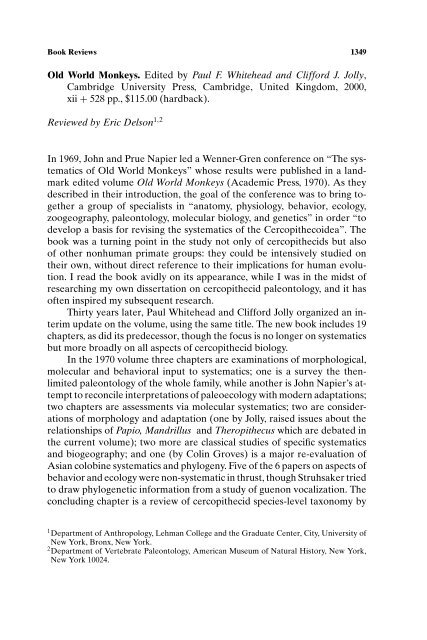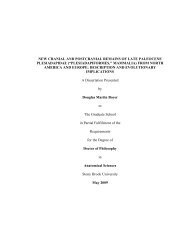Old World Monkeys. Edited by Paul F. Whitehead and Clifford J ...
Old World Monkeys. Edited by Paul F. Whitehead and Clifford J ...
Old World Monkeys. Edited by Paul F. Whitehead and Clifford J ...
You also want an ePaper? Increase the reach of your titles
YUMPU automatically turns print PDFs into web optimized ePapers that Google loves.
Book Reviews 1349<br />
<strong>Old</strong> <strong>World</strong> <strong>Monkeys</strong>. <strong>Edited</strong> <strong>by</strong> <strong>Paul</strong> F. <strong>Whitehead</strong> <strong>and</strong> <strong>Clifford</strong> J. Jolly,<br />
Cambridge University Press, Cambridge, United Kingdom, 2000,<br />
xii + 528 pp., $115.00 (hardback).<br />
Reviewed <strong>by</strong> Eric Delson 1,2<br />
In 1969, John <strong>and</strong> Prue Napier led a Wenner-Gren conference on “The systematics<br />
of <strong>Old</strong> <strong>World</strong> <strong>Monkeys</strong>” whose results were published in a l<strong>and</strong>mark<br />
edited volume <strong>Old</strong> <strong>World</strong> <strong>Monkeys</strong> (Academic Press, 1970). As they<br />
described in their introduction, the goal of the conference was to bring together<br />
a group of specialists in “anatomy, physiology, behavior, ecology,<br />
zoogeography, paleontology, molecular biology, <strong>and</strong> genetics” in order “to<br />
develop a basis for revising the systematics of the Cercopithecoidea”. The<br />
book was a turning point in the study not only of cercopithecids but also<br />
of other nonhuman primate groups: they could be intensively studied on<br />
their own, without direct reference to their implications for human evolution.<br />
I read the book avidly on its appearance, while I was in the midst of<br />
researching my own dissertation on cercopithecid paleontology, <strong>and</strong> it has<br />
often inspired my subsequent research.<br />
Thirty years later, <strong>Paul</strong> <strong>Whitehead</strong> <strong>and</strong> <strong>Clifford</strong> Jolly organized an interim<br />
update on the volume, using the same title. The new book includes 19<br />
chapters, as did its predecessor, though the focus is no longer on systematics<br />
but more broadly on all aspects of cercopithecid biology.<br />
In the 1970 volume three chapters are examinations of morphological,<br />
molecular <strong>and</strong> behavioral input to systematics; one is a survey the thenlimited<br />
paleontology of the whole family, while another is John Napier’s attempt<br />
to reconcile interpretations of paleoecology with modern adaptations;<br />
two chapters are assessments via molecular systematics; two are considerations<br />
of morphology <strong>and</strong> adaptation (one <strong>by</strong> Jolly, raised issues about the<br />
relationships of Papio, M<strong>and</strong>rillus <strong>and</strong> Theropithecus which are debated in<br />
the current volume); two more are classical studies of specific systematics<br />
<strong>and</strong> biogeography; <strong>and</strong> one (<strong>by</strong> Colin Groves) is a major re-evaluation of<br />
Asian colobine systematics <strong>and</strong> phylogeny. Five of the 6 papers on aspects of<br />
behavior <strong>and</strong> ecology were non-systematic in thrust, though Struhsaker tried<br />
to draw phylogenetic information from a study of guenon vocalization. The<br />
concluding chapter is a review of cercopithecid species-level taxonomy <strong>by</strong><br />
1 Department of Anthropology, Lehman College <strong>and</strong> the Graduate Center, City, University of<br />
New York, Bronx, New York.<br />
2 Department of Vertebrate Paleontology, American Museum of Natural History, New York,<br />
New York 10024.
1350 Book Reviews<br />
Thorington <strong>and</strong> Groves, which had a major impact on classifications through<br />
the 1970s.<br />
The 2000 volume has a rather different topical distribution. The editors<br />
begin with a broad survey of research since the Napiers’ book. Two<br />
chapters are reports on family-wide systematic studies based on cladistics,<br />
which was hardly known in 1970. Groves offers an analysis of morphological<br />
(mainly cranial) features of two groups, the genera of Cercopithecinae<br />
<strong>and</strong> the species of Cercopithecus. The results are hard to interpret as the<br />
characters are neither clearly defined nor illustrated, <strong>and</strong> I disagree with<br />
some of his subjective scoring. Balancing Grove’s chapter is one <strong>by</strong> Disotell,<br />
using molecular data, which specifically evaluates (<strong>and</strong> often rejects)<br />
phylogenic hypotheses produced <strong>by</strong> Groves <strong>and</strong> other morphologists. The<br />
impact of molecular systematics is no less great among primates than in any<br />
other group, <strong>and</strong> Disotell was among the first to accept what morphologists<br />
have long required: including multiple individuals of multiple taxa in order<br />
to underst<strong>and</strong> variation. The paper <strong>by</strong> Rogers on such molecular variation<br />
in baboons is grouped with the preceding two despite its lack of phylogenic<br />
implications.<br />
Two chapters are examinations of paleontological topics. Gundling <strong>and</strong><br />
Hill review the stratigraphic record of cercopithecids in eastern Africa, but<br />
though their work brings new information about the Tugen Hills sequence,<br />
it suffers from some errors <strong>and</strong> gaps in other areas. Benefit summarizes<br />
her work on two distinct but related aspects of cercopithecid phylogeny:<br />
the oldest well-known monkey, middle Miocene Victoriupithecus, <strong>and</strong> the<br />
dietary <strong>and</strong> environmental implications of molar morphology. She continues<br />
to press her interpretation that because cercopithecine cranial morphology<br />
is more similar to that of Victoriupithecus than that of colobines is, the former<br />
group must be relatively more primitive (or conservative), in contrast to the<br />
interpretations of Vogel, Groves, Delson <strong>and</strong> others in the 1970s. But Benefit<br />
has not sufficiently considered a possible alternative, that Victoriapithecus<br />
is already on the cercopithecine branch, as also suggested <strong>by</strong> aspects of its<br />
forelimb <strong>and</strong> pedal morphology.<br />
Of the remaining chapters in <strong>Whitehead</strong> <strong>and</strong> Jolly (<strong>and</strong> several are hard<br />
to classify due to their breadth of vision), 3 are examinations of craniofacial<br />
morphology; one morphology <strong>and</strong> life history; 2 on endocrinology as related<br />
to behavior; <strong>and</strong> 7 broadly treat behavior. Among them 2 are studies of social<br />
behavior, 2 on socioecology, 1 on locomotor behavioral ecology, <strong>and</strong> 1 on<br />
cognition. Finaly a chapter <strong>by</strong> Oates <strong>and</strong> colleagues continues the tradition<br />
of analyzing sound spectrograms to derive phylogenic information.<br />
Many of the papers will be important milestones in the areas they consider,<br />
<strong>and</strong> the volume as a whole serves as a valuable stocktaking of cercopithecid<br />
research. The editors would have done well to better integrate the
Book Reviews 1351<br />
chapters, so that the result would have been a unified book rather than a<br />
fine journal issue in hardcover. Nonetheless, it is truly a fitting tribute to the<br />
perspicacity <strong>and</strong> influence of John <strong>and</strong> Prue Napier.






